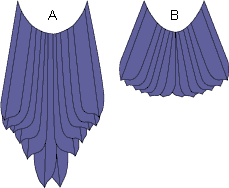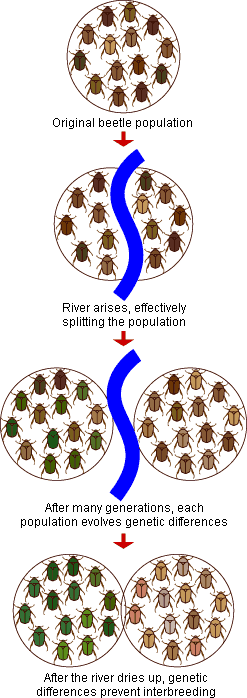 The tails of birds of paradise living in the mountains of western New Guinea (A) are longer than those of birds living in the more central mountains (B).
The tails of birds of paradise living in the mountains of western New Guinea (A) are longer than those of birds living in the more central mountains (B).

Variation between populations
Biologists realized that it was possible to explain the origin of species with genetics. Variations emerge in different parts of a species' range, creating differences between populations. In one part of a range the birds may possess long tails, in others, square tails. But because the birds also mate with their neighbors, they do not become isolated into a species of their own.
Geographic isolation
A population of birds, or any organism, can speciate if isolated from its neighbors. The most significant way to cut off a population is by geographical isolation (see illustration at right). For example, a glacier may thrust down a valley, creating two separate populations, one on either side of the glacier. A rising ocean may turn a peninsula into a chain of islands, stranding the beetles on each of them. This sort of isolation doesn't have to last forever; it needs only form a barrier long enough to let enough unique genetic changes accumulate to make the isolated population become genetically incompatible with the rest of its species. Once the glacier melts, or the ocean drops and turns the islands back into a peninsula, the animals will be unable to interbreed. They will live side by side, but follow separate evolutionary fates.Thus, species and subspecies are a living testimony to the evolutionary process.
Other modes of speciation
Today, scientists studying the origin of species can compare not just the bodies of species, but their genes as well. Geographic isolation remains a crucial element in forming new species, but a number of biologists now argue that the formation of species can take several different paths. It may be possible, for example, for a population to continue breeding with other members of its species — and trading genes — while still diverging into a distinct group. All that may be required is that a few of its genes diverge, thanks to strong natural selection. If the conditions are right, this genetically distinct population may then become a new species.
Others argue that organisms can diverge into genetically distinct populations even if they are living side by side. For example, females may be born with different preferences for mates, and those preferences may get strengthened over time into reproductive isolation. Even as biology's understanding of species formation evolves, most biologists feel that geographical isolation is probably most important to the understanding of how the millions of species on Earth came to be.